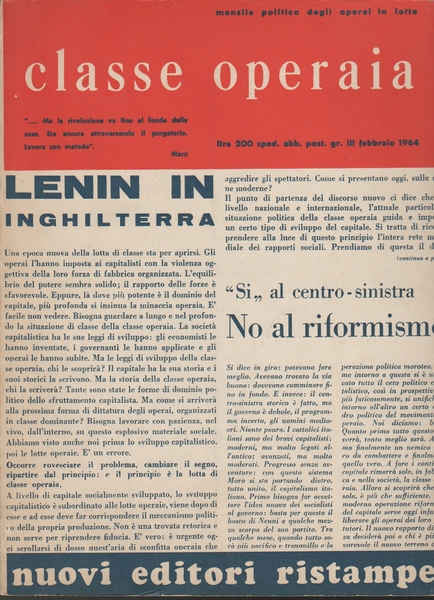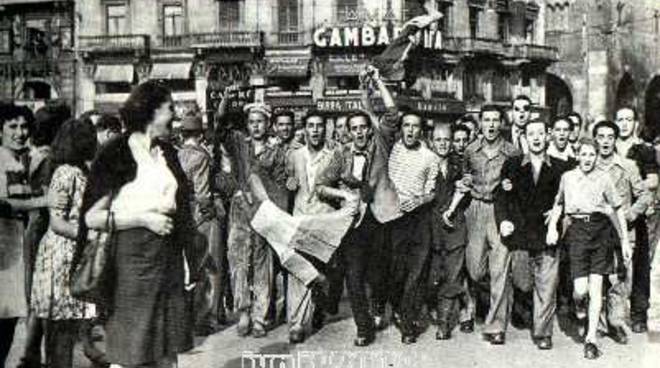In this series of posts, I introduce two responses to the resumption of large-scale strike action at FIAT in 1962 by Mario Tronti, philosopher and central figure behind the founding journal of operaismo (Workerism), Quaderni Rossi, and of the founding journal of ‘political’ Workerism, classe operaia, and an Italian Communist Party (PCI) member; as well as by Aris Accornero, trade unionist, PCI member, journalist, and editorial board member of classe operaia.[1]

In their statements, we will see the first germs of a thinking of conflict that would mark out the distinctiveness of Political Workerism’s [Operaismo politico] analysis from the dominant positions in the workers’ movement, represented by the PCI and the Italian Socialist Party (PSI), and that opposed a politics of advance through integration of conflict as lever, to a politics of conflict as break, interruption. This might be framed as posing partiality against totality, or, perhaps, a passage to the totality through the opposition of a partisan partiality, resulting in a broken totality. We shall see that this remains unsatisfying – which is to say, unresolved – but perhaps necessarily so, a necessary fragment, if such can be thought. If it can’t, so much the worse for thought.
Context
In the spring and early summer of 1962, and after years of silence, the FIAT workers once again returned to the class struggle alongside the other metalworkers, bringing 60,000 FIAT workers onto the streets of Turin to add to the 100,000 from the surrounding firms. If Ford and General Motors can be said to be the firms behind US growth for much of the 20th C., this is all the more true of Italy and FIAT. Thus, the silence or combativeness of FIAT workers was not merely an issue of ‘industrial relations’ but was an immediately political issue. This was true in 1962 as it had been in 1919-20, during the biennio rosso (the ‘two red years’), when the factory occupations at FIAT, and elsewhere, became pivotal moments in Italian history. They served not only to experiment new forms of revolutionary worker control – the factory councils – through the collective occupation and running of the factories, and as a training ground for those who would go on to establish the Italian Communist Party, all of which, repressed under the fascism, would return as the dictatorship collapsed in 1944-5. The occupations also, of course, led sectors of the liberal bourgeoisie to side with the fascists as the best way to protect capitalist property relations. In the second biennio rosso, the ‘hot autumn’ of 1968-9, again FIAT workers would be at the heart of things, and again the struggle would upset and overturn modes of conflict and struggle, once again establishing new forms of worker representation and control. In short, what happened at FIAT was critical, for good or ill, and bosses, workers, and the workers’ movement knew this well.

In part because of the critical importance of FIAT, the 1950s saw the militancy of workers within the firm – previously at the vanguard of the class struggle – come under severe repression that undermined it by a mixture of stick (the so-called fascismo di fabbrica, factory-based fascism) and carrot, comparatively higher wages, and non-wage benefits of the typical Fordist compromise; to add to this, were some tactical failures of the communist union (CGIL), which saw it lose a majority in the internal commissions[2] at FIAT for the first time (in the elections of 1955). With the FIAT workers defeated, the wind was taken out of the sails of the class struggle until 1959. In this year, the national contract was up for renegotiation and workers took to the streets in strike action in a climate of intense repression, to the point that even a Christian Democrat (DC) member of parliament objected to the anti-union and anti-worker path taken by the police and the bosses. Carlo Donat-Cattin, speaking in parliament 6 July 1959,[3] spoke of how the right to strike was spoken of by his colleagues as if it were a ‘shadow weighing upon the rule of law’, rather than what it actually was: ‘a right recognised by the Constitution’ (p. 8920). How to respond to this rising worker militancy was urgent, and the first response – building upon the wave of repression – was the formation of the Tambroni government in 1960, which involved the DC governing along with the sole support of the Italian Social Movement (MSI), the heirs to fascism. With hindsight this can be seen the last throw of the dice of the right of the Christian Democrats (DC) and the bosses, to try to keep the workers’ movement away from the leavers of power. Eventually Tambroni was brought down by largescale and widespread leftist protests, followed by police repression and further protests in a dangerous and deadly cycle. Tambroni had lasted barely 100 days, and his perhaps greatest contribution was to have unwittingly set the stage for further negotiations between the DC and the Italian Socialist Party (PSI), which eventually resulted in Fanfani’s centre-left coalition in February 1962. It was not yet the ‘organic centre left’ of 1963 onwards, but it was the first government dependent upon the negotiated abstention of part of the workers’ movement, the PSI.

This experiment caused as many problems for the left (the PCI, as well as parts of the PSI, which eventually split, and for the trade union movement) as it did for the ‘centre’ (parts of the DC and Confindustria, the employers’ organisation). The problem for the ‘centre’ was clear: conceding the need of the workers’ movement to govern, even if the smaller PSI, was to seriously undermine the leadership role of the DC and large-scale capital. For the left, the problem of what attitude to take towards the new coalition carried considerable weight, political and theoretical. Taking just the standpoint of the largest opposition party, the PCI, it can be summarised as follows: should the PCI deny outright that the Fanfani government contained any reforms of real value; or should they admit that there were some good things in the programme of government? If the party were to opt for the former, outright attack – as Pietro Ingrao on the left wished – the risk was to give the newly formed government a propaganda coup. They could then reassure business interests and their voters that it was a programme that excluded the PCI and put the communists in a position of having to critique reforms that they had previously argued for, or at least allow the government to claim that the PCI was unnecessary for important reforms to be brought about (e.g., the establishment of nation-wide middle schooling, the nationalisation of electric energy, etc.). It would also cut ties with the PSI left, and thus further isolate the party. Alternatively, if the PCI were to claim there to be good things in the programme of government, it would place the party in a subaltern position, ‘emptied of its power of contestation and of its strength in mobilising the masses and advancing the position of the PSI in the eyes of the working class’.[4]
Whether there was ever likely to be an easy time for the centre-left to be formed is an open question. It is certainly the case that February-March 1962 was probably not a propitious time since the national metalworkers’ contract was up for renegotiation. It proved to be the first testing ground for the new centre-left government. The DC, a section of the workers’ movement (PSI), and the ‘advanced’ fraction of industrial monopoly capital saw a brighter future in coordinating development, so that the state, state owned (or part-owned) firms, private monopoly capital, alongside sections of the workers’ movement, could plan the politico-economic development of Italian capitalism through joint agreement to contrast the increasing restlessness of workers (from the standpoint of the DC and monopoly capital), or integrate the workers’ movement by giving them a voice in the project of national development (from the standpoint of the PSI). Here workers’ struggle would give the PSI a stronger voice to advance its own interests (and of those it represented),[5] in the service of national development, integrating their voices – built on the strength of workers and the position of the PSI as external support of the government – in such a way as to create a virtuous relation between struggle and progressive economic growth.
(Part 2 to follow)
[1] Whereas Tronti was forced to disengage from party activism during his time writing for the journal classe operaia, Aris Accornero took the path of writing in pseudonyms in his workerists interventions (Luciano Romagnani and Giuliano Artioli in classe operaia, Arturo Vada in Contropiano) and only using his real name for the party paper l’Unità and the cultural magazine Rinascita. He also sometimes found himself in the unusual position of writing articles in Rinascita under his own name against articles in classe operaia, while still contributing to the latter journal. For instance: ‘“Operaismo” sterile. Agitazione e vuoto politico nel gruppo di Classe operaia’, in Rinascita, 40, 23 October 1965.
[2] The ‘internal commissions’ have a history going back to the early 1900s and with a shifting range of powers, depending on the balance of forces at any one time. The internal commissions are elected by all workers, regardless of union affiliation, and the commissions then represent workers according to the scope of activities, which can range from individual casework, to being able to propose changes in the labour process, or passing judgement on national bargaining, involvement in local negotiations, and many other changing functions. They also had a particularly fraught relationship with the national unions, in that sometimes the latter treated the commissions as rivals, as seeds of syndicalism to be resisted as it broke the unity of the working class. An interesting discussion of the changing function and the tensions surrounding the internal commissions, can be found here: http://www.mirafiori-accordielotte.org/rappresentanza/commissioni-interne/ (in Italian).
[3] See Donat-Cattin’s speech, pp. 8919-8923, accessed 2 November 2021:https://www.camera.it/_dati/leg03/lavori/stenografici/sed0173/sed0173.pdf
[4] See G. Tamburrano, Storia e cronaca del centro-sinistra, Rizzoli, Milan 1990: 147-48.
[5] And potentially – for a section of the PSI – to further isolate the PCI, making them appear irrelevant to the working class who’s ends could now be achieved through their own role as indispensable partner for the government’s survival.